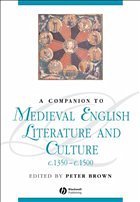Nicht lieferbar

Companion to Medieval English Literature and Culture c.1350 - c.1500
Versandkostenfrei!
Nicht lieferbar
A ground-breaking collection of newly-commissioned essays on medieval literature and culture.Encourages students to think beyond a narrowly defined canon and conventional disciplinary boundaries.Reflects the erosion of the traditional, rigid boundary between medieval and early modern literature.Stresses the importance of constructing contexts for reading literature.Explores the extent to which medieval literature is in dialogue with other cultural products, including the literature of other countries, manuscripts and religion.Includes close readings of frequently-studied texts, including texts...
A ground-breaking collection of newly-commissioned essays on medieval literature and culture.Encourages students to think beyond a narrowly defined canon and conventional disciplinary boundaries.Reflects the erosion of the traditional, rigid boundary between medieval and early modern literature.Stresses the importance of constructing contexts for reading literature.Explores the extent to which medieval literature is in dialogue with other cultural products, including the literature of other countries, manuscripts and religion.Includes close readings of frequently-studied texts, including texts by Chaucer, Langland, the Gawain poet, and Hoccleve.Confronts some of the controversies that exercise students of medieval literature, such as those connected with literary theory, love, and chivalry and war.
A Companion to Medieval English Literature and Culture c.1350-c.1500 challenges readers to think beyond a narrowly defined canon and conventional disciplinary boundaries in a number of important ways.Firstly, the companion’s date range reflects the erosion of the traditional, rigid boundary between medieval and early modern literature. Secondly, the structure of the book stresses the importance of constructing contexts for reading literature. Thirdly, the companion explores the extent to which medieval literature is in dialogue with other cultural products, including the literature of other countries, manuscripts and religion.Students will welcome the companion’s close readings of frequently studied texts, together with its discussions of larger groupings, such as the literature of religious instruction, dream poems, and chronicle and history. They will also appreciate the way the book tackles controversies, including those connected with literary theory, love, chivalry and war.
A Companion to Medieval English Literature and Culture c.1350-c.1500 challenges readers to think beyond a narrowly defined canon and conventional disciplinary boundaries in a number of important ways.Firstly, the companion’s date range reflects the erosion of the traditional, rigid boundary between medieval and early modern literature. Secondly, the structure of the book stresses the importance of constructing contexts for reading literature. Thirdly, the companion explores the extent to which medieval literature is in dialogue with other cultural products, including the literature of other countries, manuscripts and religion.Students will welcome the companion’s close readings of frequently studied texts, together with its discussions of larger groupings, such as the literature of religious instruction, dream poems, and chronicle and history. They will also appreciate the way the book tackles controversies, including those connected with literary theory, love, chivalry and war.



